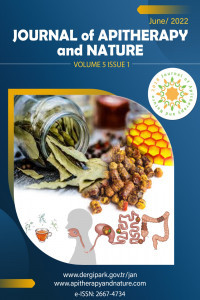North Aegean Greek Islands Propolis Antibacterial-Antifungal Activities against Malassezia
North Aegean Greek Islands Propolis Antibacterial-Antifungal Activities against Malassezia
Antibacterial-Antifungal Activities, Propolis,
___
- 1. Bankova V., de Castro S.L., Marcucci M.C. (2000). Propolis: recent advances in chemistry and plant origin. Apidologie, 31: 3-15
- 2. Graikou K., Milena P., Gortzi O., Bankova V., Chinou I. (2016). Characterization and biological evaluation of selected Mediterranean propolis samples. Is it a new type? LWT-Food Science and Technology, 65: 261-267.
- 3. Velegraki A., Alexopoulos E.C., Kritikou S., Gaitanis G. (2004). Use of fatty acid RPMI 1640 media for testing susceptibilities of eight Malassezia species to the new triazole posaconazole and six established antifungal agents by a modified NCCLS M27-A2 microdilution method and E-test. Journal of Clinical Microbiology, 42: 3589-3593.
- Yayın Aralığı: Yılda 2 Sayı
- Başlangıç: 2018
- Yayıncı: Oktay YILDIZ
What We Know, and Don't Know, about the Benefits of Propolis to Honey Bee Health
Effects of Propolis on the Quorum Sensing of Selected Biofilm Producing Bacterial Species
K. TENNICK, S. WAFA, H. FEARNLEY, M. GOMEZ ESCALADA
Portuguese Propolis: A Potenial Source of Environmentally Friendly Fungicides
Catarina PASSÃO, Claudia RODRIGUES, Cristina Almeida AGUIAR, Ana CUNHA
Portuguese Propolis: A Source of Valuable Bioactivities
A CUNHA, H ALVES, C ARAÚJO, L BARROSO, M CRUZ, As FREİTAS, Aj GOMES, R GONÇALVES, R MARQUES, B MOREİRA, C PASSÃO, M PEİXOTO, H PEREİRA, R SİLVA-CARVALHO, İ VALENÇA, Am FERREİRA, F BALTAZAR, F PİNTO-RİBEİRO, S CARDOSO, R OLİVEİRA, C ALMEİDA-AGUİAR
Toothpaste with Propolis “Apident” Shows Antimicrobial Activity in vitro
Klemen RIHAR, Dunja Gregorič EXEL, Adriana PEREYRA, Rok KOPINČ, Bratko FILIPIČ
Chemical Composition of Selected Propolis Samples from Kyrgyzstan and Kazakhstan
Argyro PETROPOULOU, Konstantia GRAIKOU, Jaroslaw WIDELSKI, Krystyna SKALICKA-WOŹNIAK, Zuriyadda SAKIPOVA, İoanna CHINOU
İsamara Julia CAMURI, Adriano Batista COSTA, Wallance Moreira PAZIN, Amando Siuiti ITO
The Biological Activities of Indonesian Propolis and It’ s Molecular Marker
Muhamad SAHLAN, Diah Kartika PRATAMI, Safira Candra ASIH, Andrea DEVINA, Alfiani Guntari MAHADEWI, Masafumi YOHDA, Siti FARIDA, Robiatul ADAWIYAH, Herbert SITUMORANG, Heri HERMANSYAH, Anondho WIJANARKO
New Antiproliferative Acyl Glycerols from New Zealand Propolis and Source Poplar Resin
Stephen BLOOR, Owen CATCHPOLE, Kevin MITCHELL, Rosemary WEBBY
Mihaela NICULAE, Laura STAN, Adriana URCAN, Timea DOMOKOS, Daniel S. DEZMIREAN, Otilia BOBIS
